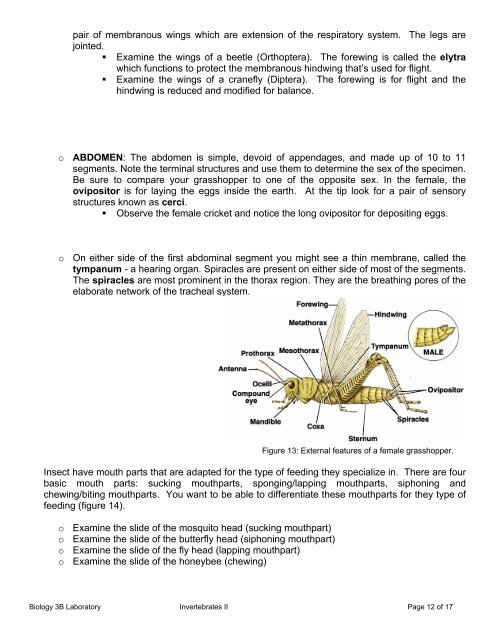Biology 3B Laboratory Invertebrates II: Annelida, Nematoda ...
Biology 3B Laboratory Invertebrates II: Annelida, Nematoda ...
Biology 3B Laboratory Invertebrates II: Annelida, Nematoda ...
You also want an ePaper? Increase the reach of your titles
YUMPU automatically turns print PDFs into web optimized ePapers that Google loves.
pair of membranous wings which are extension of the respiratory system. The legs are<br />
jointed.<br />
• Examine the wings of a beetle (Orthoptera). The forewing is called the elytra<br />
which functions to protect the membranous hindwing that’s used for flight.<br />
• Examine the wings of a cranefly (Diptera). The forewing is for flight and the<br />
hindwing is reduced and modified for balance.<br />
o ABDOMEN: The abdomen is simple, devoid of appendages, and made up of 10 to 11<br />
segments. Note the terminal structures and use them to determine the sex of the specimen.<br />
Be sure to compare your grasshopper to one of the opposite sex. In the female, the<br />
ovipositor is for laying the eggs inside the earth. At the tip look for a pair of sensory<br />
structures known as cerci.<br />
• Observe the female cricket and notice the long ovipositor for depositing eggs.<br />
o On either side of the first abdominal segment you might see a thin membrane, called the<br />
tympanum - a hearing organ. Spiracles are present on either side of most of the segments.<br />
The spiracles are most prominent in the thorax region. They are the breathing pores of the<br />
elaborate network of the tracheal system.<br />
Figure 13: External features of a female grasshopper.<br />
Insect have mouth parts that are adapted for the type of feeding they specialize in. There are four<br />
basic mouth parts: sucking mouthparts, sponging/lapping mouthparts, siphoning and<br />
chewing/biting mouthparts. You want to be able to differentiate these mouthparts for they type of<br />
feeding (figure 14).<br />
o Examine the slide of the mosquito head (sucking mouthpart)<br />
o Examine the slide of the butterfly head (siphoning mouthpart)<br />
o Examine the slide of the fly head (lapping mouthpart)<br />
o Examine the slide of the honeybee (chewing)<br />
<strong>Biology</strong> <strong>3B</strong> <strong>Laboratory</strong> <strong>Invertebrates</strong> <strong>II</strong> Page 12 of 17

















